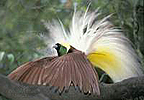| 
|
|
|
-
- Halmahera
- Ternate, an island off the west coast of Halmahera
in northern Maluku, was once the seat of an important kingdom
which prospered from the spice trade. The Portuguese, the Spanish
and the Dutch vied with each other for influence on this island.
A stronghold of Islam in the otherwise predominantly Christian
province of Maluku,
Ternate nevertheless carries the clear imprints of both its pre
Islamic past and its period of contact with the West, especially
the Portuguese.
The old sultan's palace in Ternate town is now a museum. In the
vicinity are the ruins of old Portuguese, Spanish and Dutch forts.
The remnants of the Dutch Fort Orange are right in town.
About five kilometers west of the town, on the slope of a 1,715
meter tall volcano in the middle of the island, is Afo, with its
giant clove tree, said to be more than 360 years old to be the
ancestor of all clove trees in the world.
Morotai Island, just off Halmahera's northern arm, was an important
airbase during World War II, first for the Allies and later for
~the Japanese until its recapture near the end of the war. The
ghosts of war still linger in this area, where many wrecks of
aircraft and rusting guns lie abandoned in the bushes.
-
- Ceram Island
- One of the biggest island in Maluku. The beaches in
Ceram are generally beautiful and suitable for swimming, fishing
etc. Sea gardens, Sago woods, Maiden forests. Naulu race, who
still keep their habits and traditional way of life. Exotic nature,
flora and fauna, Manusela National Park, Kasa islet and Babi islet
surrounded by white sandy beaches, beautiful spots for swimming
and fishing and gorgeous sea gardens. Wonderful waterfall and
beautiful surrounding panorama in the village of Rumakai Antiques.
- Banda
- The Banda group, about 132 kilometers southeast of
Ambon, consists of three larger islands and seven smaller ones,
perched on the rim of Indonesia's deepest sea, the Banda Sea.
Near the island Manuk, the water reaches a depth of more than
6,500 meters.
Of the three biggest islands Banda, Banda-Neira and Gunung Api,
the first two are covered with nutmeg trees and other vegetation.
The third however, is entirely bare and highly volcanic. The last
eruption of Mt. Api occurred only a few years ago. The seas around
Banda are the site of the famous Maluku sea gardens with their
bright corals and colorful fish darting through the crystal- clear
waters. Facilities for sightseeing, snorkeling and skin diving
are available, as well as clean, comfortable cottages. Banda saw
some of the bloodiest episodes of Maluku's past history during
the 17th century.
In 1609, the Dutch East Indies Company (VOC) dispatched Verhoeff
to the islands to obtain the contested spice trade monopoly at
any cost. Confronted by a superior power, the people of Banda
were forced to allow the company to establish a fort, but in that
same year Verhoeff was killed together with 45 of his men. The
Company retaliated, but peace was not restored. In 1619, VO.C.
Governor-General Jan Pieterszoon Coen arrived at the head of a
penal expedition and exterminated the entire population of Banda.
The land was divided into lots, called "perken", and
given to former company employees, the "perkiniers",
who were obliged to grow nutmeg and sell them at predetermined
prices to the company. Slaves did the actual work in the fields.
The old "perkenier houses", or what is left of them,
and old churches still retain a peculiar colonial character to
the port town of Bandaneira today.
Two old forts Belgica and Nassau, are inside the town limits.
Others are found elsewhere on the islands. See also the former
Dutch Governor's mansion, the Museum of History in Neira, and
the huge nutmeg plantation nearby.
-
|
|
|
 |















